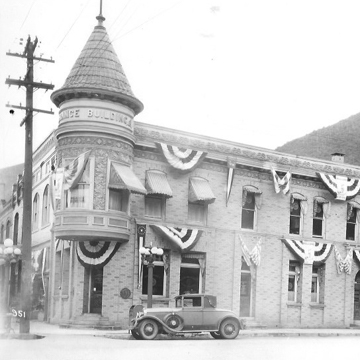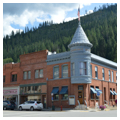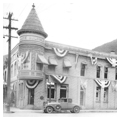You are here
Rossi Insurance Building
The intersection of Sixth and Bank streets contains an imposing group of buildings in downtown Wallace. What is now the Rossi Insurance Building was erected as a one-story building in 1890 for the Bank of Wallace, which failed within the year; it was replaced by the First National Bank of Wallace in 1892. The second story and pressed-metal turret were added in 1895, mimicking the White and Bender Building across Sixth Street. The rear entrance features double doors with leaded glass, which are topped with a fan window pattern of elaborate leaded glass.
Insurance executive Herman Rossi bought the building in 1917 and changed the lettering on the turret. Rossi was an extraordinary personality who served as four-time mayor of Wallace, an Idaho State Representative, a University of Idaho regent, chairman of the Idaho Board of Education, president of the Wallace Board of Trade, and a lieutenant colonel in the Idaho National Guard. In 1916, he publicly killed a man in the lobby of Wallace’s largest hotel but was found not guilty; the judge was Rossi’s business partner. As mayor in 1929, Rossi was in open defiance of Prohibition, and was arrested and convicted for participation in an event known as the North Idaho Whiskey Rebellion.
Rossi Insurance continues to occupy the building, making it the oldest established business in downtown Wallace.
Writing Credits
If SAH Archipedia has been useful to you, please consider supporting it.
SAH Archipedia tells the story of the United States through its buildings, landscapes, and cities. This freely available resource empowers the public with authoritative knowledge that deepens their understanding and appreciation of the built environment. But the Society of Architectural Historians, which created SAH Archipedia with University of Virginia Press, needs your support to maintain the high-caliber research, writing, photography, cartography, editing, design, and programming that make SAH Archipedia a trusted online resource available to all who value the history of place, heritage tourism, and learning.

















